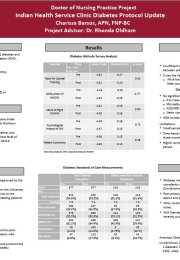- Resource Types
- Resource Languages
- Institutional Repository
 Visit the home page
Visit the home page
About Site Language
WHDL is viewable in multiple languages. Use the pull-down menu to select a language to view the site.
I changed my language, but I’m still seeing resources in the other languages?
If a resource or text has not been translated into your selected language, it will appear in the initially added language. We are always looking for help translating these resources. If you can help, contact us!
WHDL - 00017798


The constant changes in diabetes guidelines make it difficult to care for high-risk patients, particularly Native Americans. Diabetic patients are generally medically complex, with multiple comorbidities caused by diabetes or closely linked to the disease. In an Indian Health Service in Northern California, the diabetes protocol was outdated, and best care standards were not followed. The project helped to increase the providers' knowledge about the standards of care. The project supported the clinic’s primary care providers in their efforts to provide the highest level of diabetic care to the Native American population and all diabetic patients. Meleis et al. (2000) nursing theory of experiencing transitions was applied to this project. Tools used included a pre-survey and a post-survey, namely the Diabetes Attitude Survey from the University of Michigan Diabetes Research and Training Center, given to the providers to complete. Patient data were also collected before and after protocol implementation, including A1c, microalbumin, diabetic retinopathy exam, foot exam, Angiotensin-converting enzyme inhibitors (ACE) or Angiotensin II receptor blockers (ARB) use, and statin use. There was insufficient evidence to suggest significant mean differences between the pre-survey and post-survey. There was a slight increase in the number of foot and eye exams completed pre- to post-implementation. No significant change was noted in A1c measurement, microalbumin measurement, ACE/ARB use, or statin use. This project had several limitations, including a small sample size, a short period for data collection, and high pre-survey diabetes attitude scores. Recommendations for the future include a larger sample size for both the Diabetes Attitude Test and diabetic patients. A more extended period for the study would also be beneficial.